written by Dr. Victor Ezquerra, Metro Music Makers instructor
Acoustic instruments (flute, congas, voice) were the first musical instruments to be played by humans; they produce musical sounds by using force to make the instrument vibrate. Electric instruments like the electric guitar, synthesizer and microphones require electricity to function as they are intended. They need to be amplified and must have their signal transferred from the instrument to yield the final, audible sounds. Digital instruments (tablets, MIDI controllers) rely on computing or processing power to generate musical sounds from a digital signal. Acoustic instruments are readily understood by our ears, while the signal of electric and digital instruments has to be converted from their electric form to be heard by humans. Every single acoustic, electric and digital instrument has a unique means of creating music and distinct sound.
Introduction
It is worth exploring the unique and distinct nature of different types of instruments in order to better understand how and why instruments play, function and sound differently. In this blog, I have provided information about acoustic instruments, electric instruments and digital instruments. Having increased knowledge of instruments helps musicians craft and control their music more precisely, and helps us better understand how music is created and transmitted. I have provided many links so you can listen, see, and enjoy all these fantastic instruments and the beautiful sounds they create.
What Are Acoustic Instruments? (Types, Families)

Acoustic instruments are the oldest musical instruments and also the easiest to understand how they function. Acoustic instruments do not require any electricity, amplification or computer processor to produce a sound. Almost universally, acoustic instruments need human exertion (movement or breath) to be played; the noise that is made comes directly from some sort of force being applied to the instrument. Acoustic instruments are often classified by the way the sound is created. Some broad, commonly recognized categories are:
- String Instruments — The vibration of a string(s) makes the sound. The string can be struck (clavichord or hammer dulcimer), plucked/strummed (guitar, harp, banjo, ud, guqin), or bowed (violin, erhu, hurdy-gurdy). Check out some very cool string instruments from around the world.
- Wind Instruments — Sound is created through the vibration of air through the instrument. Wind instruments can vary greatly. Some utilize reservoirs of air called bellows to store and build up air pressure (accordion, organ, bagpipes); some use the vibration of thin pieces of material called reeds to produce sound (saxophone, clarinet, oboe, harmonica); other wind instruments are reedless (flute, didgeridoo, recorder); mouthpiece instruments (tuba, trombone, trumpet) rely on the vibration of a player’s lips. Here’s a video with awesome wind instruments from around the globe.
- Percussion Instruments — These instruments make noise by being struck, shaken or scraped. They can be struck with sticks or mallets (drum set, gong, marimba) or with hands (bongos, congas). Shakers are played exactly as implied by their name—they make noise when you shake them (maracas, rattles, shekere, caxixi). Scrapers also have a fitting name; they are played by scraping their body with a stick. Scrapers include the guiro, yu and cog wheel. Some percussion instruments have a clearly distinguishable pitch (xylophone, glockenspiel, bells, steel drums). Although every sound has a pitch, many percussion instruments are considered to be unpitched (snare drum, cymbals) because their pitch is largely indeterminable. Check out these unique percussions instruments from different cultures.
It is worth noting that no system of classification is perfect. For example, if using the system above, a piano could be considered a string instrument because it has strings, but could also be categorized as a percussion instrument because the strings are struck like a percussion instrument. To gain more insight into how musical instruments are classified, read up on systems of classification that have emerged in different cultures throughout history.
How Are Acoustic Instruments Different From Electric and Digital Instruments?
As mentioned before, sound travels in waves. Acoustic instruments are played, then the sound vibrates the air and reaches your ear. There are only two requirements for acoustic instruments to make sound: the instrument and force to make it vibrate. Electric and digital instruments require other things to produce a musical sound—electricity, connection and communication between the gear, and a way to amplify the signal. With non-acoustic instruments, the sound must travel through other mediums before it is audible.
Think of a cell phone conversation: one person speaks audibly and another hears the person talking, but several things happen in between. The signal is translated into different “languages” between the speaker and the listener. The phone deciphers the sound, the signal is carried from one place to another, and finally it is converted back to a voice the listener hears through a speaker. Likewise, electric and digital instruments must be translated into different languages during the journey from player to final sound. The route that is traveled from sound creation to final broadcast is called the signal path or signal chain. The signal path of an acoustic instrument is the most basic path possible. Electric instruments add a layer of technology that requires an electric current and translation of the electrical language back to an acoustic signal that can be perceived by the human ear. Digital instruments add yet another layer/language to the signal chain—they require computing in addition to electricity and final translation back to an audible acoustic sound.
What Are Electric Instruments?

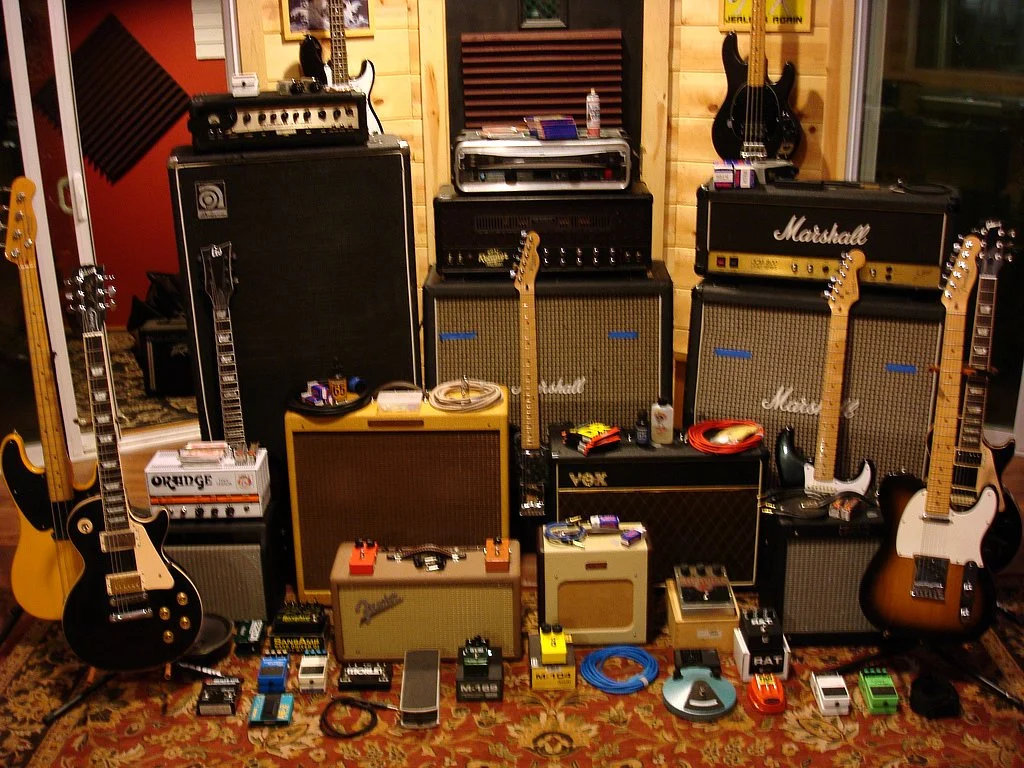
Until the early 20th century, acoustic instruments dominated the music industry. Advancements in technology and manufacturing allowed people to play, perform, and record music in new and exciting ways. With amplification, recording techniques, and new instruments, musicians were able to play larger venues, record and layer multiple tracks, and create sounds like never before. Changing the tone color of an acoustic instrument relies on the player to make physical changes with technique or the instrument itself; electric instruments are able to alter the sound through circuitry and adjustments done through the electrical signal and its components.
Som
e examples of electric instruments include electric guitar, synthesizers, electric organ, electric bass guitar and theremin. In some cases, electrical components are used to amplify and alter an instrument’s acoustic sound. For example, an electric guitar produces an acoustic sound when played, but needs to be plugged into an amplifier and powered to be played as it was designed. In other instances, such as a Moog synthesizer, the instrument produces no acoustic sound unless it is powered and amplified.
Electric instruments have the ability to take a signal carrying a wave form (similar to the wave forms of different instruments pictured above) and alter the wave form in numerous ways. They do so through the use of knobs, switches, buttons and slides to control components that ultimately change the sound created by the instrument. A synthesizer produces sound by generating basic wave forms (like the ones in the photo below) and then altering and combining those wave forms. The resulting sound can be similar to an existing instrument, or can produce a totally unique sound. Listen to basic waveforms here.

What Are Digital Instruments?
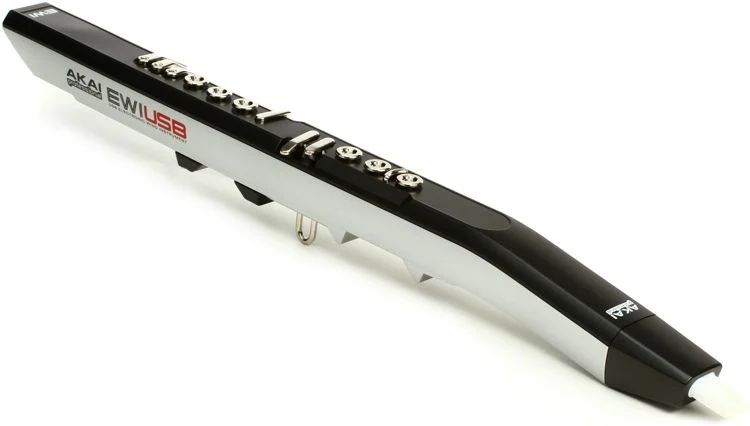



Digital instruments require electricity AND computing to produce their intended musical sounds. Electronic Digital Instrument, or EDI, is another commonly used term to describe musical instruments that use programmable software to play music. The language EDIs use to communicate audio information is unique because it needs to be interpreted by a processor. Some digital instruments have the capability to function independently (like an electric drum set); others require external software or processing to be programmed and used (like a MIDI pad).
One important component of digital music-making is MIDI—Musical Instrument Digital Interface. An interface can allow non-digital instrument signals to be converted into a digital signal, which can then be interpreted, recorded and edited by digital software. Many interfaces serve as mixers that allow for audio to be adjusted before reaching a computer. A MIDI controller is a digital instrument that produces digital signals that are readily deciphered by a computer. MIDI controllers often have familiar layouts, like a keyboard or a DJ station with crossfader.
Digital instruments include computers, tablets, phones, MIDI controllers and EWIs (electronic wind instruments). Like the cascade of musical change brought about by electric instruments in the early 20th century, arguably to a greater extent, the popularization of digital music-making that started in the 1980’s has drastically altered the musical landscape. It is now simpler and more accessible than ever for musicians to engage music in a plethora of ways. Manipulating sound from creation to performance to recording has been transformed by digital musical instruments. Click here for a more expansive look at the history of digital instruments.
What Is the Difference Between Analog and Digital Electric Instruments?
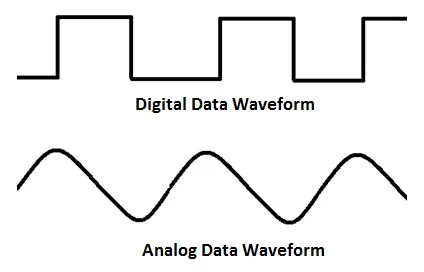
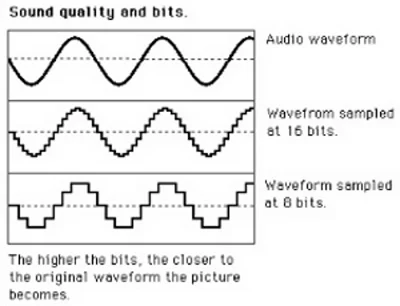
All digital instruments are electric, but not all electric instruments are digital. Analog instruments produce a continuous electrical signal, typically varying in voltage. In other words, analog signals are constant and have infinite values along the wave, while digital signals are intermittent signals with finite values. As the pictures above show, an analog instrument produces a smooth waveform with endless points along the curve. Digital instruments mimic analog waveforms by changing specific values in incremental steps; if the steps are increased and made smaller, the digital wave looks and sounds more like an analog wave. Click here for a more detailed explanation of the differences between digital and analog technologies.
Example of a Signal Path with Acoustic, Electric and Digital Instruments
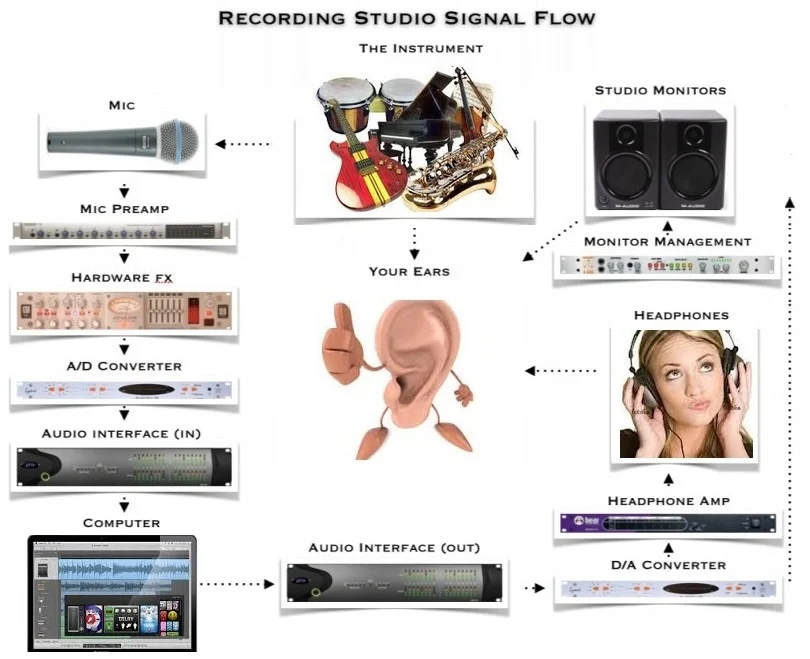
The signal path of a musical sound can be traced logically. When I record an electric guitar part, the signal begins with the acoustic vibration of my strings, which is sensed by pickups on the guitar (transducers that pick up the strings’ vibrations). After traveling from my guitar, an electrical signal goes through a cable into digital and analog effects pedals where the sound/signal is altered before reaching a tube amplifier; the digital pedals shape the signal digitally, but the input and output signals are analog. The signal enters the amplifier, is amplified/boosted, and comes out of a speaker. I use a microphone to capture the sound coming from the speaker, which then travels to an interface. Up until this point, the path has been transmitted through an analog signal, but my computer input does not understand that language. The interface converts or translates the analog signal into a digital one, so that the sound being recorded by my microphone can be recognized and stored by software on my computer. Since humans can’t hear music as voltages or digital signals, every signal path we hear will end with acoustic sounds transmitted to our ears.
The signal chain described above could be written this way (A=acoustic sounds, N=analog electric voltage, D=digital signal):
(A) Guitar string vibration=> (N) guitar pickups=> (N & D) effects pedals=> (N) guitar amplifier=>
(A) sound from guitar speaker=> (N) microphone=> (N/D) interface=> (D) computer=> (D) recording
Software=> (N) headphones or speakers=> (A) sound waves to ears
Conclusion
There are many differences between instruments: how they are played, the technological requirements for instruments to be played properly, how their signal is transmitted, and why the resulting sounds are unique. Understanding the differences helps us become more a
ware of how music is created and why we hear it the way we do. Despite the vast differences amongst acoustic, electric and digital instruments, they all have the same goal—to make music.
